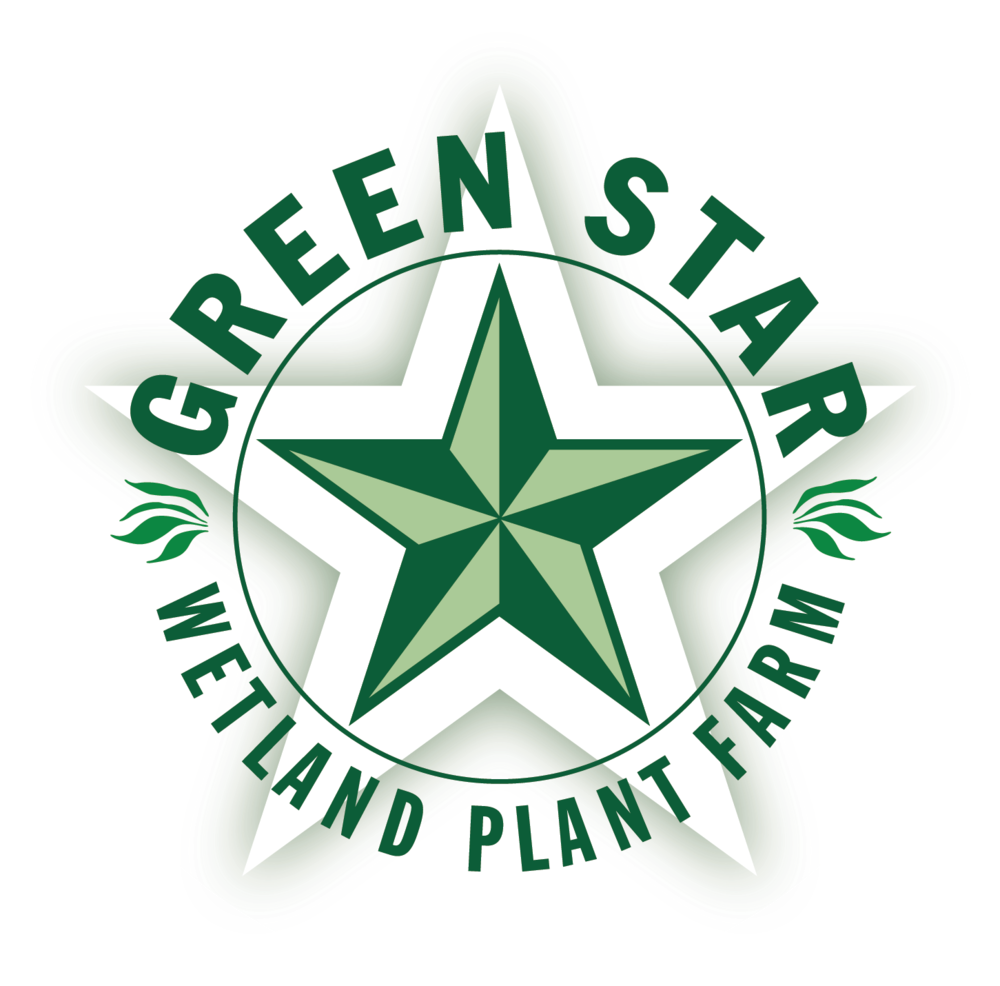About Wetlands
WHAT ARE WETLANDS?
Southern blue flag iris (Iris virginica)
Wherever shallow water meets the land, a unique zone develops: a wetland. These zones may be freshwater or saltwater, natural or man-made, a few square feet or thousands of acres, but they all have characteristic plants, soils, wildlife, and many benefits to people and the environment. Native wetland plants have adapted over thousands of years to challenging conditions.
Because of this, native varieties can handle alternating floods and droughts, occasional mowing and pollutants—all while providing sustenance and habitat for wildlife, and beautiful flowers or foliage. This is why Green Star specializes in locally-sourced, native wetland plants.
The significance of wetlands is becoming more widely known and their use is on the rise. Paradoxically, the interest in wetlands comes at a time when wetlands in many areas have disappeared. Millions of acres have been drained, leveled and paved, or have eroded away. However, we have the resources to bring back lost landscape functions— through wetland restoration, mitigation, conservation and construction.
treatment and stormwater wetlands
Green Star provides consultation on wetland maintenance, including this stormwater pond at MD Anderson Cancer Center.
New approaches to designing flood control basins are transforming them from simple containers of nuisance water to parkland which filters and improves stormwater runoff. Stormwater can be a contaminated brew of excess nutrients from lawn fertilizer, sediment from construction sites, bacteria from pet waste, and hydrocarbons and heavy metals from cars and roadways. In wetlands, multiple natural processes combine to remove these contaminants as the water gradually moves downstream.
WETLAND conservation, restoration & MITIGATION
Student volunteers unload plants at a restoration site on Greens Bayou near Houston.
Whether bringing an existing wetland to a higher standard, or returning land to its former wetland status, the best plants for a project are those that are indigenous to that area. Plants with the same botanical names, but origins that are states apart, have adapted differently, will grow differently, and will interact with other species differently. Green Star strives to discover and maintain native populations of plants best suited to regions in Texas and the Gulf Coast. The ongoing loss of habitat makes each surviving population important, and each restoration, mitigation and conservation project vital.
Aquatic Landscapes & Garden Features
Our crew staging plants at a new Houston Zoo exhibit.
Garden-like settings can be created to showcase various aspects of wetlands: beautiful assemblages of plants, magnets for wildlife, water storage, and water cleansing. Outstanding landscapes are made by combining these functions!
Rain gardens and bioswales catch rainwater in a shallow depression planted with species that can take a few inches of water for several days, then go dry between rains. Fortunately, many of our Gulf Coast natives have adapted naturally to take extremes like this. We generally stock Giant coneflower, Spiderwort, Bushy bluestem, Buttonbush, Inland sea oats, Wooley rose mallow, Spider lily, Swamp lily, Lizard tail, and other species for these conditions.
A bog garden does not generally have standing water but is designed to stay wet, either by situating it in a low spot or by giving it a liner. Spikerushes, Bacopas, Arrowheads, Pickerel, native Irises, and other species will thrive in these conditions.
A pond does have standing water, of course, and falls anywhere between a puddle and a lake in size. Most wetland species will prefer less than 6” depth, but California bulrush, Squarestem spikerush, and Pickerel will spread over time into water 12” deep. Deeper than that, Water lilies, Spatterdock, and floating plants like Bladderwort take charge.
WHAT KINDS OF PROJECTS NEED NATIVE WETLAND PLANTS?
✿ Wetland restoration
✿ Conservation
✿ Mitigation
✿ Constructed treatment wetlands
✿ Storm-water wetlands
✿ Landscape water features
✿ Bog gardens
✿ Rain gardens and bioswales
✿ Green infrastructure
Wetlands Provide THE FOLLOWING BENEFITS:
Filtration for improving water quality
Pollutants such as bacteria, sediments, heavy metals, fertilizer and petrochemical compounds naturally settle out or are broken down in wetlands.
Essential habitat for birds, pollinator species, other wildlife
Over half of all North American bird species depend on wetlands for some part of their life cycles.
Floodwater storage
Each acre-foot of floodwater in a wetland area keeps 325,851 gallons of water out of homes and businesses.
Flood attenuation
Maintaining just 15% of the watershed as wetlands can reduce flooding peaks by 60%, according to the US EPA.
Erosion buffer for storm events
Roots hold onto soil, and stems diffuse wave energy, preventing erosion.
Evapotranspiration
Through this natural process, floodwater is removed faster in areas with wetland vegetation than without.
Groundwater recharge
Depending on the soil type, wetlands contribute to maintaining the water table.
Carbon storage
Estuarine (saltwater) wetlands pack enormous amounts of carbon from atmospheric carbon dioxide into the soil.
Outdoor recreation
Wetlands are a destination for hunters, birdwatchers, hikers and photographers, all bringing revenue to the community.
Wetlands are essential habitat for mosquito-eating dragonflies, like this one resting on a Wooley rose mallow leaf.





